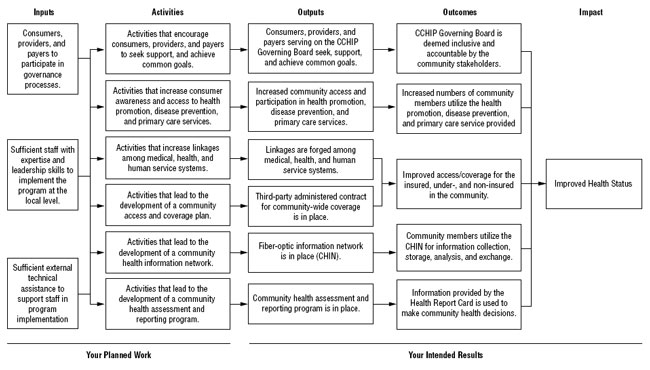
When conducting a rigorous and high quality evaluation of a program implementation, it is critical that the research team contemplate and fully explain the logic model. The development of the logic model not only helps frame the research process, but also teases out many details that may not be addressed elsewhere when planning such a study. Presented as a graphical display or narrative, the logical model should be thorough in detail, but easy for different stakeholders to understand.
What is a logic model?
A logic model (or theoretical framework) is a detailed and comprehensive description of all related intervention components and the pathways to outcomes desired. Written by the researcher it explains the construct under study that needs to be addressed and the significant change they believe their intervention will bring to solve a problem or improve a situation. There are several important components of a logic model:
A detailed description of the population under study including any demographic factors such as gender, race, location, socioeconomic status, educational level, and environment.
Problem at hand: the logic model should fully explain the precise problem the intervention is going to impact. Level of stress and specific standardized test scores are good examples. The logic model should explain how this is measured, how your population currently measures on the construct, why this problem needs to be addressed, and how your intervention is going to address it.
Description of Intervention: the program discussion should start with a detailed outline of your intervention and the theoretical basis for its development. The details include an overview of the content or curriculum to be delivered including time spans. This would include any printed materials (books, handouts, or packets), procedures, activities, meetings, professional development, technology, instructional strategies and assessments. Inputs should be discussed at this time including personnel, funding, and equipment. Activities of your intervention should also be discussed which would include the delivery of curriculum as well as work with other stakeholders. A rationale for why your intervention should work is included in this section as you detail each piece and its importance to the outcome.
Outputs: In your logical model you will talk about immediately results that will be produced as a result of your intervention. This is the short term gain. This can include number of meetings to raise awareness on an issue, number of books read, number of skills mastered.
Outcomes: Here we clearly identify the participation outcomes and measures to track improvement. During this section of the logical model goals for the subjects should be discussed including short-term outcomes and the long-term outcomes. If there are going to be successful change for others including teachers, school, district staff, parents and the community then those should be clearly explained. In this context, measurement of short-term outcomes are often referred to as mediators, for example, changes in teacher behaviors that are assumed to have a connection to long-term outcomes.
Impact: With any intervention our hope is to create long-lasting change for our participants, and your logic model is going to want to address those benefits. This can include the direct impact on long-term student achievement, and emotional competencies as well as the benefits to the school, district and educational system as a whole.
Assumptions: Most programs are based on one or more assumptions that can not be proven or guaranteed, but are critical to success. Assumptions can include an implied outcome such as “less stress leads to better test scores,” or that the classroom will be an effective environment for the delivery of the program. Assumptions are also based on staff hiring and retention, parent participation, or that a particular product will continue to be available.
External factors that can not be controlled but which could have an impact are included. This can include competing programs and those that may work against the program under discussion. Home life pressure and exposure to outside resources can not be controlled but could both have a substantial impact on results.
Having these details clearly defined and presented as a logic model sets the foundation for the program implementation and evaluation. This way stakeholders, from funding agents to parents have a clear understanding of the plan.
